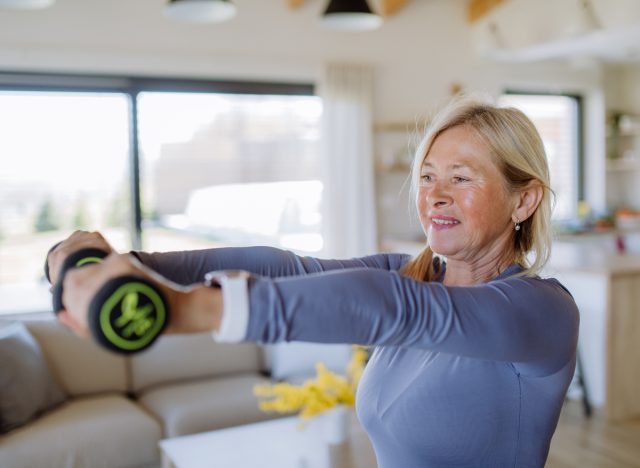Over 60? Here’s What Happens When You Exercise One Hour per Week

A little bit really can go a long way when it comes to working out. If you’re over 60, an expert shares exactly what happens to your body when you exercise one hour a week. Whether you’re on a time crunch or simply want to keep things short and sweet with your routine, you can still enjoy the wonderful benefits of physical activity by dedicating one hour of your time each week.
According to the Centers for Disease Control and Prevention (CDC), older individuals can reap the benefits of regular exercise—and workouts don’t need to be vigorous. Even if you’ve been leading a more sedentary lifestyle, you can kick things off with quick intervals of moderately intense exercise (five to 10 minutes), and slowly increase along the way. As with any new exercise program, if you’re over 60, you should always check in with your healthcare provider before starting.
We spoke with Matt Morris, master trainer and programming manager, NASM-CPT at Burn Boot Camp, who reveals what happens to your body after 60 when you exercise one hour a week. So lace up your sneakers, and get ready to learn all about the benefits!
What happens to your body when you exercise one hour a week?

According to Rush University System for Health, losing energy is a natural side effect of aging. Your surroundings and genes can cause changes in your cells, which results in the loss of both strength and mass in your muscles. In addition, as you age, your muscles aren’t as flexible as they once were. Needless to say, engaging in more vigorous activities can become extra fatiguing.
But don’t stress, because growing into your older years certainly doesn’t mean you should write off exercise! Morris outlines some of the main benefits of exercising one hour a week for individuals who are over 60. They include—but are not limited to—enhanced strength, which will boost your overall quality of life; improved balance, which can lower your chances of suffering from falls; a nice little energy boost every day; enhanced cognitive function; and the prevention of bone loss.
Science backs this up. According to research conducted by an international team of researchers from Australia, Norway, and the UK, engaging in just 60 minutes of physical activity each week could help you avoid depression down the road. “Assuming the relationship is causal, 12% of future cases of depression could have been prevented if all participants had engaged in at least one hour of physical activity each week,” the researchers wrote.
In addition, according to the Mayo Clinic, you’ll burn some impressive calories while engaging in one hour of exercise! For instance, low-impact aerobics can torch around 365 calories for a 160-pound individual, water aerobics can burn around 402 calories, swimming laps can melt away about 423 calories, and walking can burn about 314 calories.
What are the best exercises to do after 60?
You’ve likely heard this before, but strength training is king—especially as you age. This is because growing older comes with the loss of lean muscle mass, and strength training can help you preserve and build it back up. “Strength training is the most important kind of exercise routine for an improved quality of life as someone ages,” Morris says.
In addition to strength training sessions, Morris explains Pilates and yoga are stellar low-impact workouts that contribute to a greater range of motion in all of your joints. And don’t skip out on swimming, cycling, or rowing. “[These are] other types of low-impact exercise routines that will provide aerobic benefits, [such as] strengthening [your] cardiovascular health and lung capacity.”









